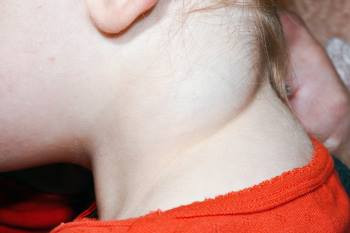Definisi
Limfangioma merupakan suatu kista (rongga) berisi cairan bersifat jinak yang terjadi di pembuluh kelenjar getah bening tubuh. Pembuluh kelenjar getah bening bekerja bersama membentuk suatu sistem limfatik yang bekerja untuk mengatur cairan di dalam jaringan tubuh. Kelenjar getah bening juga bekerja untuk membantu sistem pertahanan tubuh dalam melawan infeksi.
Angka kejadian limfangioma berkisar 1 dari 4000 kelahiran. Limfangioma dapat terjadi di mana pun, baik di kulit atau membran mukosa (lendir), terutama di area kepala atau leher sekitar 75% dari total kasus. Sekitar 50% kasus limfangioma pada kepala atau leher ditemukan saat lahir dan 90% kasus baru dikenali saat berusia 2 tahun.
Penyebab
Penyebab pasti kasus limfangioma masih belum diketahui hingga saat ini. Kelainan perkembangan sistem kelenjar getah bening saat di dalam kandungan diduga menjadi dasar munculnya limfangioma. Limfangioma yang muncul saat lahir diakibatkan oleh terbendungnya sistem kelenjar getah bening yang terjadi di dalam kandungan. Selain itu, limfangioma juga sering dihubungkan dengan kelainan genetik tertentu, seperti Trisomi 13, 18, dan 21, hingga beberapa sindrom klinis tertentu seperti sindrom Down.
Faktor Risiko
Hingga saat ini belum diketahui secara pasti mengenai faktor risiko terhadap kejadian limfangioma. Tidak ada ras tertentu yang lebih dominan terjadinya limfangioma. Meskipun demikian, berdasarkan bukti yang ada saat ini, angka kejadian paling sering pada kasus limfangioma ditemukan pada saat lahir atau usia awal kehidupan.
Gejala
Limfangioma setempat pada area tertentu dapat berjumlah satu atau banyak di tubuh. Gejala yang muncul dapat beragam bergantung pada ukuran dan lokasi terjadinya limfangioma. Limfangioma dapat tampak sebagai bintil kecil yang berwarna merah atau kebiruan. Apabila cairan kelenjar getah bening berakumulasi, pembengkakan dan benjolan dapat tampak pada kasus limfangioma.
Apabila limfangioma terjadi pada organ atau jaringan tubuh yang penting, maka gejala yang dapat muncul dapat bermakna dan menurunkan kualitas hidup seseorang. Jika limfangioma terjadi pada lidah, maka kesulitan makan dan berbicara dapat menjadi keluhan yang dirasakan. Pandangan ganda apabila limfangioma terjadi pada area kantong mata (eye socket). Nyeri dada hingga sulit bernapas dapat terjadi jika limfangioma muncul pada area dada.
Diagnosis
Diagnosis limfangioma dapat ditegakkan sebelum lahir melalui pemeriksaan ultrasonografi (USG) untuk melihat adanya kelainan yang tampak. Jika dokter baru mengetahui adanya kelainan setelah lahir, maka dokter biasanya akan meminta pemeriksaan lebih lanjut seperti MRI atau CT scan atau USG untuk menegakkan diagnosis dan menilai ukuran dan dampak yang dapat ditimbulkannya. Apabila limfangioma tidak tampak terlihat saat lahir, terkadang baru dapat timbul saat anak berusia 2 tahun.
Meskipun demikian, selain pemeriksaan penunjang, dokter akan melakukan wawancara medis dan pemeriksaan fisik terlebih dahulu untuk lebih menegakkan diagnosis ke arah limfangioma. Wawancara medis yang akan dilakukan meliputi gejala dan waktu munculnya limfangioma yang ada.
Pemeriksaan fisik akan membantu lebih detail untuk menilai kondisi limfangioma yang ada. Pada limfangioma dapat ditemukan adanya bintil-bintil bergerombol berwarna merah hingga ungu atau lenting berisi darah yang berada di permukaan kulit. Selain itu, juga dapat ditemukan ada pembengkakan akibat terhambatnya aliran kelenjar getah bening karena gangguan sistem kelenjar getah bening sejak lahir terutama area leher.
Pemeriksaan fisik juga dapat membantu untuk memeriksakan keluhan Anda lebih lanjut apabila Anda merasa ada limfangioma di tempat lain selain kulit. Dokter yang melakukan pemeriksaan fisik pada diri Anda akan meminta Anda untuk berbaring terlentang.
Pemeriksaan penunjang lainnya seperti pemeriksaan lab darah lengkap dapat dipertimbangkan untuk mengetahui apakah sudah ada keterlibatan infeksi pada limfangioma.
Tata Laksana
Umumnya tidak ada penanganan tertentu yang dapat dilakukan untuk tata laksana limfangioma. Dokter cenderung tidak menyarankan terapi apapun apabila tidak ada gejala tertentu atau gejala yang dirasakan ringan. Apabila limfangioma berukuran besar, membuat tidak nyaman atau menurunkan kualitas hidup, dokter akan menyarankan beberapa terapi yang dapat dikerjakan bila memungkinkan.
Tata laksana yang direncanakan akan bergantung pada tipe, ukuran, dan lokasi dari limfangioma. Beberapa pilihan tata laksana yang dapat dilakukan, meliputi proses pembedahan, skleroterapi, terapi laser atau ablasi radiofrekuensi.
Proses pembedahan yang dilakukan akan membuang kista limfangioma namun apabila benjolan terletak dekat dengan organ dan saraf maka termasuk kasus sulit yang perlu ditangani secara hati-hati.
Skleroterapi merupakan proses penyuntikan zat kimia tertentu langsung ke dalam benjolan yang diharapkan bahwa benjolan tersebut akan mengecil dan menghilang. Penanganan dengan metode ini lebih sering digunakan dan memiliki angka keberhasilan yang hampir mirip dengan proses pembedahan namun dengan komplikasi yang lebih sedikit.
Terapi laser atau ablasi radiofrekuensi merupakan metode penanganan yang memerlukan laser dan jarum suntuk untuk mengirim panas untuk menghancurkan benjolan yang ada akibat limfangioma.
Meskipun ada beberapa tata laksana dalam penanganan limfangioma, hampir sulit untuk menghilangkan atau menghancurkan seluruh sel dari limfangioma sehingga limfangioma cenderung dapat kembali muncul di tempat yang sama. Oleh karena itu, terkadang dibutuhkan waktu yang lebih lama dan proses bedah atau tata laksana yang berulang untuk menghilangkan limfangioma secara penuh.
Angka kejadian berulang dari kasus limfangioma beragam bergantung pada tipe dan lokasi dari limfangioma.
Komplikasi
Komplikasi yang dapat muncul pada kasus limfangioma adalah limfangioma circumscriptum. Limfangioma circumscriptum dihubungkan dengan perdarahan minimal, selulitis (penyakit radang yang memerah pada kulit dengan batas tegas) yang berulang dan keluarnya cairan kelenjar getah bening. Dialaporkan juga ada 2 kasus limfangiosarkoma yang berasal dari limfangioma circumscriptum. Meskipun demikian, pada kasus tersebut, diketahui bahwa sudah ada paparan terapi sinar X yang panjang pada limfangioma yang ada sehingga terapi radiasi sebaiknya dihindari pada pasien dengan limfangioma.
Limfangioma lainnya dapat menyebabkan kesulitan makan, masalah pernapasan, dan infeksi yang serius apabila terjadi pada area leher. Apabila terjadi pada skrotum (kulit yang melapisi buah zakar), maka dapat muncul beberapa komplikasi seperti akut skrotum (nyeri skrotum) hingga perdarahan meskipun jarang terjadi.
Pencegahan
Pencegahan terhadap kejadian limfangioma hingga saat ini belum diketahui dengan pasti. Meskipun demikian, ada beberapa langkah yang dapat dilakukan untuk membantu dalam mencegah terjadinya komplikasi yang mungkin dapat terjadi pada kasus limfangioma. Berikut ini langkah-langkahnya:
- Mengenali lebih dini adanya limfangioma yang tampak pada permukaan kulit atau organ lainnya dengan memeriksakan diri kepada dokter
- Melakukan pemeriksaan rutin atau medical check up terutama pada anak-anak yang berisiko memiliki limfangioma, misalnya pasien dengan sindrom Down
- Melakukan pemeriksaan USG untuk ibu hamil ke dokter untuk mengetahui apakah ada kelainan yang terlihat pada anak yang sedang dikandung
Kapan Harus ke Dokter?
Jika Anda mengalami gejala dan tanda yang persisten dan terus-menerus, disertai perburukan, sebaiknya Anda memeriksakan diri lebih lanjut ke dokter spesialis bedah (Sp.B) atau spesialis kulit dan kelamin (Sp.KK). Dokter akan melakukan wawancara medis, pemeriksaan fisik, hingga pemeriksaan penunjang tertentu untuk menetapkan diagnosis pasti dan tata laksana yang tepat.
Mau tahu informasi seputar penyakit lainnya? Cek di sini, ya!
- dr Anita Larasati Priyono
Medscape. Lymphangioma. April 2021. https://emedicine.medscape.com/article/1086806-overview
Healthline. Lymphangioma. September 2017. https://www.healthline.com/health/lymphangioma
Miceli A, Stewart KM. Lymphangioma. [Updated 2021 Aug 12]. In: StatPearls [Internet]. Treasure Island (FL): StatPearls Publishing; 2022 Jan-. Available from: https://www.ncbi.nlm.nih.gov/books/NBK470333/








